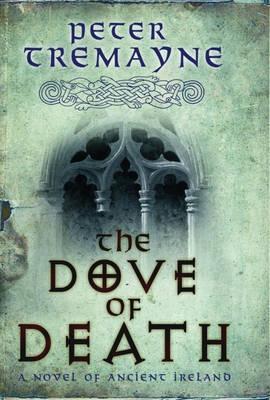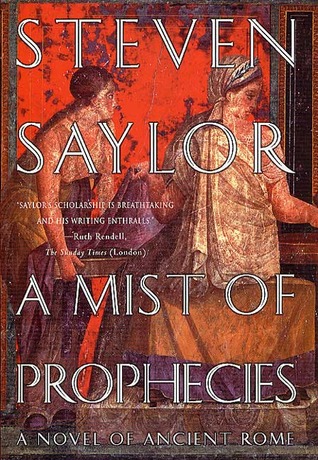I received this book for free from the library in exchange for an honest review. This does not affect my opinion of the book or the content of my review.
Source: the library
Behold a Pale Horse
by
Peter Tremayne
It is part of the , series and is a historical mystery in Hardcover edition that was published by Headline Publishing on July 17, 2012 and has 384 pages.
Explore it on Goodreads or Amazon
Other books by this author which I have reviewed include Valley of the Shadow, The Dove of Death, The Chalice of Blood, Murder Most Medieval: Noble Tales of Ignoble Demises, The Seventh Trumpet, Atonement of Blood, The Second Death
This is the twenty-second installment in the Sister Fidelma medieval mystery series, but the action takes place after Shroud for the Archbishop which places it in the number 3 slot chronologically. It’s the summer of 664 and Sister Fidelma finds herself stranded in Italy on her way home from the activity in Rome. The action in this story takes place in the then Abbey of Bobium (today’s Abbey of Bobbio).
My Take
I do enjoy how precise Fidelma is. They certainly don’t like Fidelma’s questions!
All the controversy in this novel is over two things whether God the Father, God the Son, and God the Holy Spirit is truly three-in-one or if the Father is superior to the Son who is superior to the Spirit (the Arian belief). So typical of Man to be more worried about idiot details than the actual life s/he is living! The second issue is power. Who reigns, who dies.
A council of men chose one way belief and exiled all the others. With a change in rulers, came a change in which view was accepted with a reverse in who is exiled and so it goes, back and forth.
Fidelma’s Irish upbringing intrigues the Italian nobles. They are so used to deference from all let alone from a woman. There’s also an interesting discussion about the contrast between how rulers are created as well. I do much prefer the Irish way.
It doesn’t feel as much like a mystery as a look at the history of the area, an exploration of the politics involved, and an examination of the differences in religious beliefs. The beliefs are actually a separate issue while the history definitely affects the politics. I also get a glimpse of the bandit lords who plagued the area of the Italian countryside for so many centuries.
[“Longobard” was the original term between 568 and 774 A.D. for the Lombards.]This was a very convoluted mystery and quite clever on Tremayne’s part, the way in which he designed all the twists and turns. He must’a done a heap of research on the time period, the area, and the religious issues.
Why is Fidelma being so obtuse? Why isn’t she questioning whether she was given an accurate translation of the woman’s words? It seems so un-Fidelma-like.
The Story
Anxious for home after events in Shroud for the Archbishop, Fidelma cannot help her reaction to the men stalking an elderly religieux. It’s pure chance that Magister Odo also knows Father Raduan, her teacher and the man she has loved as a father. When she hears of his condition, nothing will stop Fidelma from visiting him.
When she arrives at the Abbey of Bobium, she is warned of the evil that is in the valley, of the storm that is coming. That she should leave for her home NOW.
They don’t know Fidelma well at all. Especially when murder is afoot.
The Characters
Sister Fidelma is also a princess of Chasel and a dálaigh, an Irish lawyer. She’s heading home from events in Rome when her ship encounters difficulties and must put back to Genua.
Monks at the Abbey of Bobium include:
Magister Odo is a highly respected, scholarly monk whom Fidelma rescues from assassins in Genua. Brother Faro and Sister Gisa have come to escort him back to the abbey. They’re also in love.
Abbot Servillius is in charge and is hated by Bishop Britmund who leads the Arian sect whereas the abbot abides by the Council of Nicaea. Other brothers include the Venerable Ionas, a scholar; Brother Wulfila is the steward; Brother Hnikar is their apothecary; Brother Ruadán is Hibernian and Fidelma’s old teacher; Brother Lonán cares for the abbey’s herb garden; Brother Eolann is their librarian and another traitor; Brother Waldipert is the cook; and, Brother Bladulf is the gatekeeper.
Radoald is the Lord of Trebbia and fights on the side of King Grimoald. Wulfoald is the commander of Radoald’s armies and seems quite intelligent and competent. Suidor is Radaold’s physician. Aistulf is a hermit in Trebbia.
Romuald is Prince of the Longobards, the son and heir of Grimoald. Lady Gunora is his loyal nurse and they have sought sanctuary at the abbey, poor souls. Lupus the Wolf, the Duke of Friuli, is Grimoald’s regent while the king is in the field with his army.
Wamba is a goatherd in the wrong place as is his mother, Hawisa. Odo is Hawisa’s nephew who takes on her goats and provides useful evidence.
Grasulf is the Lord of Vars and will sell his allegiance to him with the fattest money bag. Krakko is his jovial steward.
Perctarit was king before being overthrown by Grimoald and Perctarit adheres to the Nicaean decision, but accepts support from Arians. While Grimoald is an Aria, but allows both. The Lord of Turbigo is the brilliant Commander in Perctarit’s army as well as a good strategist.
The Cover and Title
It’s a pale lime green cover right down to the Celtic knots forming the exterior side borders as well as the frame for the inset picture of a white horse caparisoned in gold-trimmed red on a green, grassy hillside high above the abbey and its Roman-built bridge. A shield of lightning and a laurel wreath rests against a protruding rock. The wreath makes sense, but it was a flaming sword mentioned in the book. Not lightning.
The title refers to the horse the murderer rides and is also a biblical reference for death: Behold a Pale Horse and the name that sat on him was death”.















